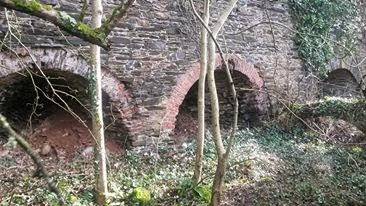Cornelius the Elder was a progressive farmer
who died in 1779. In succeeding his father, Cornelius the MP was to become a serious businessman. He would also be an MP for Waterford on several occasions and would hold several other posts including Mayor and Sheriff.
In 1885 the Mail Packet station was moved to the village of Cheekpoint and it would appear this was to become a serious driver of the industrial plans. This also coincided with government policy to diversify textile manufacture away from Dublin and substantial subsidies were provided by parliament to villages such as Balbriggen in Dublin, Prosperous in Kildare and Cheekpoint and New Geneva in Waterford.1
Below is a brief list of the achievements of both Boltons, as I find it impossible to separate the activities of one from the other regarding the earlier developments. This is also incomplete. As two of the items were only added in the last few weeks. I imagine it would take serious historical research to unearth all that the Bolton’s were involved in.
- Ballycanavan House
- Brooke Lodge
- 300 Acres of woodland including the Oak woods around Faithlegg and the Glazing wood
- Double Lime Kilns (2 at Jack Meades, 2 at Faithlegg and 1 at Cheekpoint) (that I know of)
- Triple kiln at Ballycanavan
 |
| Triple kiln |
- Water Mill at Jack Meades
 |
| Old water mill, Jack Meades |
- Water Mill at Ballycanavan
- Commercial Ice House at Jack Meades
- Forge on Redmonds Hill
- Draining of and reclaiming of Marshes including containing walls
- Textile Industry at Cheekpoint – (Thirty stocking frames, 22 looms for linen and cotton2
- Brick making factory
- Rope walk in Cheekpoint
- Mail packet station at Cheekpoint
- Daisybank house – Hotel for the mail packet
 |
| Daisybank House |
- Cheekpoint quay (replaced with the present quay circa 1870)
- Realignment and improvement to main road to Waterford (including the mileposts)
- Two slate quarries at the Barn Quay
- Mining operations for cobalt
- An interest in the plans for New Geneva project
- Faithlegg House
- Demesne and Deerpark
in the area or linked to placenames such as the rope walk at the Rookery and
the Village Green – most probably a blanching green where the cotton was spread
out to dry in the sun. Others such as the Mail Packet are survived by the milepost,
the house where the captain who ran it – Captain Owen, resided and his daughter
poetess Elisabeth Owen in Fairymount, or by the Hotel which was established to cater for
passengers, now Daisybank house.
building of Faithlegg House. It was
built in 1783 and the architect was believed to be John Roberts. Roberts was responsible for some of the
finest buildings in Waterford at the time
including the Bishop’s Palace, both cathedrals, City Hall,
Theatre Royal and my own favourite the Chamber of Commerce Building at the top
of Gladstone Street. As Roberts had a country home in the Glen in Faithlegg, it would have been relatively easy
for him to oversee the work. There may be another connection, but one I only heard of, that Bolton paid for the spire on the protestant cathedral.
many initiatives to sustain his business ideas, none of his endeavours seems to
have paid off. The slate quarries were
of poor quality, no Cobalt was found. The ending of the Napoleonic wars led to a slump in demand for textiles. The 1798 uprising and the the act of Union must have also impacted. Perhaps the biggest impact was the shifting of the mail packet station downriver because of the delay in getting the ships to Cheeekpoint.
In a desperate attempt to stave off his creditors Bolton sold off parts of his operation and land, but ultimately he lost it all. On March 1st 18163 he was forced to sell Faithlegg house
to repay part of his debts. 199 years ago this week.
 |
| Bolton’s plot and extended family, old Faithlegg Church |
1 Ed Aalen FHA, Whelan K & Stout M. Atlas of the Irish Rural Landscape. 2003. Cork University Press p 189
2 Ed Fewer TN, I was a Day in Waterford 2001. Ballylough Books. pp 49-53 (excerpt from Julian Walton)
3 “Links and Landmarks being a calendar for the year 1900 recording curious and remarkable events in the history of Waterford city from the earliest times to the present day ” compiled by M. J. Hurley
courtesy of Micheal O Sullivan Waterford History Group, without whom I would not have known this specific detail and who I would like to thank for the title.
Various people will have helped me with information for this piece who I can no longer recollect, but most recently Gerry Boland gave me some info on the Faithlegg Kilns which I was not aware of.
